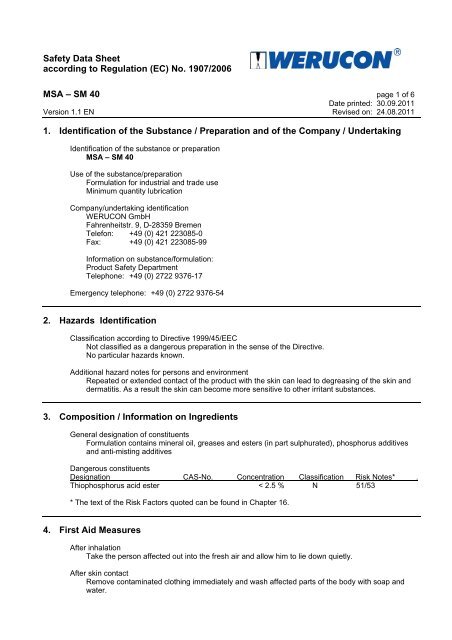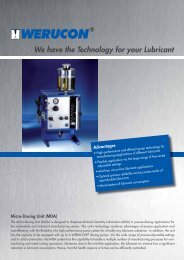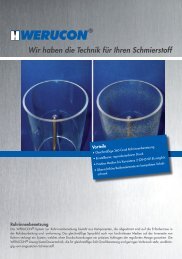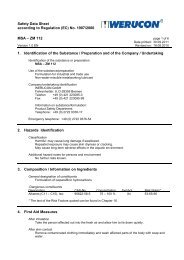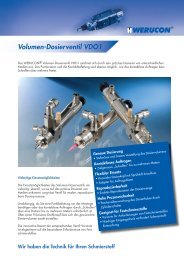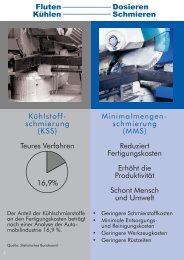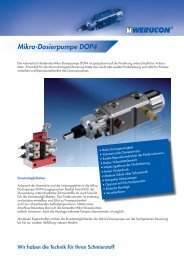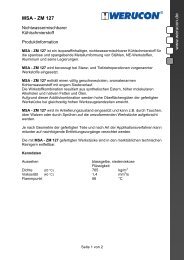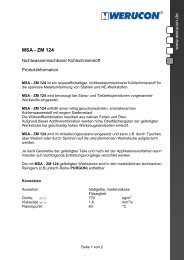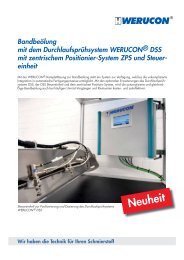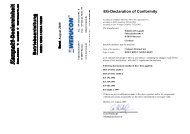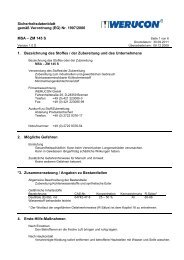Safety Data Sheet according to Regulation (EC) No. 1907/2006 MSA
Safety Data Sheet according to Regulation (EC) No. 1907/2006 MSA
Safety Data Sheet according to Regulation (EC) No. 1907/2006 MSA
You also want an ePaper? Increase the reach of your titles
YUMPU automatically turns print PDFs into web optimized ePapers that Google loves.
<strong>Safety</strong> <strong>Data</strong> <strong>Sheet</strong><br />
<strong>according</strong> <strong>to</strong> <strong>Regulation</strong> (<strong>EC</strong>) <strong>No</strong>. <strong>1907</strong>/<strong>2006</strong><br />
<strong>MSA</strong> – SM 40 page 1 of 6<br />
Date printed: 30.09.2011<br />
Version 1.1 EN Revised on: 24.08.2011<br />
1. Identification of the Substance / Preparation and of the Company / Undertaking<br />
Identification of the substance or preparation<br />
<strong>MSA</strong> – SM 40<br />
Use of the substance/preparation<br />
Formulation for industrial and trade use<br />
Minimum quantity lubrication<br />
Company/undertaking identification<br />
WERUCON GmbH<br />
Fahrenheitstr. 9, D-28359 Bremen<br />
Telefon: +49 (0) 421 223085-0<br />
Fax: +49 (0) 421 223085-99<br />
Information on substance/formulation:<br />
Product <strong>Safety</strong> Department<br />
Telephone: +49 (0) 2722 9376-17<br />
Emergency telephone: +49 (0) 2722 9376-54<br />
2. Hazards Identification<br />
Classification <strong>according</strong> <strong>to</strong> Directive 1999/45/E<strong>EC</strong><br />
<strong>No</strong>t classified as a dangerous preparation in the sense of the Directive.<br />
<strong>No</strong> particular hazards known.<br />
Additional hazard notes for persons and environment<br />
Repeated or extended contact of the product with the skin can lead <strong>to</strong> degreasing of the skin and<br />
dermatitis. As a result the skin can become more sensitive <strong>to</strong> other irritant substances.<br />
3. Composition / Information on Ingredients<br />
General designation of constituents<br />
Formulation contains mineral oil, greases and esters (in part sulphurated), phosphorus additives<br />
and anti-misting additives<br />
Dangerous constituents<br />
Designation CAS-<strong>No</strong>. Concentration Classification Risk <strong>No</strong>tes* .<br />
Thiophosphorus acid ester < 2.5 % N 51/53<br />
* The text of the Risk Fac<strong>to</strong>rs quoted can be found in Chapter 16.<br />
4. First Aid Measures<br />
After inhalation<br />
Take the person affected out in<strong>to</strong> the fresh air and allow him <strong>to</strong> lie down quietly.<br />
After skin contact<br />
Remove contaminated clothing immediately and wash affected parts of the body with soap and<br />
water.
<strong>Safety</strong> <strong>Data</strong> <strong>Sheet</strong><br />
<strong>according</strong> <strong>to</strong> <strong>Regulation</strong> (<strong>EC</strong>) <strong>No</strong>. <strong>1907</strong>/<strong>2006</strong><br />
<strong>MSA</strong> – SM 40 page 2 of 6<br />
Date printed: 30.09.2011<br />
Version 1.1 EN Revised on: 24.08.2011<br />
After eye contact<br />
If product comes in<strong>to</strong> contact with eyes, carry out thorough rinsing immediately with plenty of water<br />
and consult a doc<strong>to</strong>r.<br />
After swallowing<br />
Do not induce vomiting. Rinse out the mouth with water immediately and drink water. Get medial<br />
attention.<br />
5. Fire-Fighting Measures<br />
Suitable extinguants<br />
Foam, CO2, dry powder extinguant<br />
Unsuitable extinguant for safety reasons<br />
Jet of water<br />
Special hazards from the substance or the actual product, its combustion products or gases produced<br />
COx, SOx, phosphorus oxides<br />
Special protective equipment for fire-fighting<br />
In the event of fire, use breathing apparatus suitable for any ambient conditions.<br />
Additional notes<br />
The disposal of fire residues and contaminated fire-protection water must be carried out in<br />
compliance with official regulations.<br />
6. Accidental Release Measures<br />
Personal precautionary measures<br />
Remove sources of ignition. Avoid skin and eye contact. Use personal protective equipment.<br />
Caution - Slippery surface through leakage of product.<br />
Environmental protection measures<br />
Do not allow product <strong>to</strong> get in<strong>to</strong> surface waters, the sewage system or the soil. Inform the<br />
responsible authorities if the product escapes in<strong>to</strong> surface bodies of water, sewer systems or the<br />
ground.<br />
Cleaning/elimination procedure<br />
Absorb liquid with oil or universal binders and carry out disposal in compliance with official<br />
regulations.<br />
*7. Handling and S<strong>to</strong>rage<br />
Handling<br />
<strong>No</strong>tes on safe handling<br />
Avoid allowing the product <strong>to</strong> come in<strong>to</strong> contact with unprotected parts of the skin; use suitable<br />
gloves if necessary (e.g. of nitrile rubber). Prevent the formation of vapours and aerosols. Ensure<br />
adequate ventilation, if necessary with the aid of local extraction systems.
<strong>Safety</strong> <strong>Data</strong> <strong>Sheet</strong><br />
<strong>according</strong> <strong>to</strong> <strong>Regulation</strong> (<strong>EC</strong>) <strong>No</strong>. <strong>1907</strong>/<strong>2006</strong><br />
<strong>MSA</strong> – SM 40 page 3 of 6<br />
Date printed: 30.09.2011<br />
Version 1.1 EN Revised on: 24.08.2011<br />
S<strong>to</strong>rage<br />
Requirements for s<strong>to</strong>rage rooms/conditions<br />
Protect from frost and heat. S<strong>to</strong>re in closed containers. Take precautions <strong>to</strong> prevent the building up<br />
of electrostatic charges.<br />
Containers and filling equipment is <strong>to</strong> be handled/s<strong>to</strong>red in such a manner that endangerment of<br />
water and soil from leakage of product can be excluded water.<br />
<strong>No</strong>tes on mixed s<strong>to</strong>rage<br />
S<strong>to</strong>rage Class 10, flammable liquids if not LGK 3 (LGK = S<strong>to</strong>rage Class) (TRGS 510) (TRGS =<br />
Technical rules for hazardous substances)<br />
Specific use(s)<br />
Formulation for industrial and trade use<br />
Minimum quantity lubrication<br />
BGR/GUV-R 143 “Activities involving coolant lubricants” is <strong>to</strong> be observed<br />
8. Exposure Controls / Personal Protection<br />
Exposure limit values<br />
Workplace limit-value<br />
Designation of substance Remarks .<br />
The product contains no relevant quantities of individual substances with workplace-related limit values<br />
that have <strong>to</strong> be moni<strong>to</strong>red.<br />
Exposure controls in the workplace<br />
Protection and Hygiene measures<br />
Keep away from food and drink. Do not put cleaning cloths saturated with product in your pockets.<br />
Wash your hands before breaks and meals. After work, use moisturizing skin cream. Observe<br />
workplace-related skin protection plan.<br />
Personal protection equipment<br />
Respira<strong>to</strong>ry protection<br />
<strong>No</strong>t necessary with adequate ventilation.<br />
Hand protection<br />
Use protective gloves of suitable material (e.g., nitrile rubber, penetration time > 480 min) tested<br />
<strong>according</strong> <strong>to</strong> EN 374.<br />
Use suitable skin protection cream that is not dissolved by oil if gloves cannot be worn.<br />
Observe skin protection plan.<br />
Eye protection<br />
Wear protective goggles with side protection if there is a risk of splashing.<br />
Skin protection<br />
Wear industrial clothing.<br />
Environmental exposure controls<br />
See data in Point 6<br />
9. Physical and Chemical Properties
<strong>Safety</strong> <strong>Data</strong> <strong>Sheet</strong><br />
<strong>according</strong> <strong>to</strong> <strong>Regulation</strong> (<strong>EC</strong>) <strong>No</strong>. <strong>1907</strong>/<strong>2006</strong><br />
<strong>MSA</strong> – SM 40 page 4 of 6<br />
Date printed: 30.09.2011<br />
Version 1.1 EN Revised on: 24.08.2011<br />
Appearance<br />
Form liquid<br />
Color yellow<br />
Odor weakly characteristic<br />
Important data on health and environmental protection and safety<br />
Basic safety-relevant parameters<br />
pH-value ( g/l water, 20°C) not applicable<br />
Melting range not determined °C<br />
Boiling point/boiling range not determined °C<br />
Flammability 190 °C<br />
Ignition temperature not determined °C<br />
Vapour pressure (20°C) < 0.01 hPa<br />
Density (20°C) 892 kg/m³<br />
Water solubility (20°C) insoluble in g/l<br />
practical terms<br />
Partition coefficient:<br />
n-octanol/water (log POW) not determined<br />
Viscosity, kinematic (40°C) 37 mm²/s<br />
10. Stability and Reactivity<br />
Conditions <strong>to</strong> avoid<br />
Substance is stable when handled for the intended purpose under the usual conditions of use.<br />
Observe notes on s<strong>to</strong>rage.<br />
Materials <strong>to</strong> avoid<br />
Powerful oxidizing agents<br />
Hazardous decomposition products<br />
In the event of fire: COx, SOx, phosphorus oxides<br />
*11. Toxicological Information<br />
General remarks<br />
Acute <strong>to</strong>xicity, skin irritation, mucosal irritation, genotype change potential and skin-sensitization of<br />
the formulation were assessed on the basis of the data available for the individual components. To<br />
some extent, there are gaps in the data for individual components. However our experience<br />
indicates that hazards going beyond those covered by the classification symbol are not <strong>to</strong> be<br />
expected.
<strong>Safety</strong> <strong>Data</strong> <strong>Sheet</strong><br />
<strong>according</strong> <strong>to</strong> <strong>Regulation</strong> (<strong>EC</strong>) <strong>No</strong>. <strong>1907</strong>/<strong>2006</strong><br />
<strong>MSA</strong> – SM 40 page 5 of 6<br />
Date printed: 30.09.2011<br />
Version 1.1 EN Revised on: 24.08.2011<br />
Practical experience<br />
Our experience so far has shown that when the basic rules of industrial protection and industrial<br />
hygiene are observed and the product is handled in accordance with the intended purpose, no<br />
detriment <strong>to</strong> health is <strong>to</strong> be expected. Splashes in the eyes and prolonged skin contact are <strong>to</strong> be<br />
avoided.<br />
Other information<br />
Classification is carried out in accordance with directive 1999/45/EU.<br />
12. Ecological Information<br />
Eco<strong>to</strong>xicity<br />
The product is a liquid that is a hazard for water; it should not be allowed <strong>to</strong> get in<strong>to</strong> the earth,<br />
sewers or surface bodies of water.<br />
Mobility<br />
<strong>No</strong> statements available<br />
Persistence and degradability<br />
<strong>No</strong> statements available<br />
Bioaccumulation potential<br />
<strong>No</strong> statements available<br />
Other harmful effects<br />
The product contains no organically bound halogens. It does not contribute <strong>to</strong> the AOX value.<br />
*13. Disposal Considerations<br />
Disposal / waste (product)<br />
Pass <strong>to</strong> approved waste-disposal company with due observance of official local regulations.<br />
EU waste codes<br />
12 01 07 mineral-based machining oils free of halogens (except emulsions and solutions)<br />
Packing<br />
Completely empty containers. Pass <strong>to</strong> approved waste-disposal company. Drums and containers<br />
can be reconditioned. Cleaning by recycling firm.<br />
14. Transport Information<br />
<strong>No</strong>t a hazardous substance as defined by ADR, RID, IMDG, ADNR, ICAO/IATA<br />
15. Regula<strong>to</strong>ry Information<br />
Identification<br />
<strong>No</strong>t classified <strong>according</strong> <strong>to</strong> E<strong>EC</strong> Directives<br />
Other <strong>EC</strong> regulations
<strong>Safety</strong> <strong>Data</strong> <strong>Sheet</strong><br />
<strong>according</strong> <strong>to</strong> <strong>Regulation</strong> (<strong>EC</strong>) <strong>No</strong>. <strong>1907</strong>/<strong>2006</strong><br />
<strong>MSA</strong> – SM 40 page 6 of 6<br />
Date printed: 30.09.2011<br />
Version 1.1 EN Revised on: 24.08.2011<br />
Details concerning Directive 1999/13/<strong>EC</strong> on the limitation of emissions of volatile organic<br />
compounds (VOC-RL): none<br />
National regulations (Germany)<br />
Water endangerment class<br />
WGK 1 (slight water endangerment, VwVwS – Administrative Register – Substances hazardous <strong>to</strong><br />
water - Annex 4)<br />
16. Other Information<br />
Text of R-phrases in section 3<br />
R 51/53 Toxic <strong>to</strong> aquatic organisms, may cause long-term adverse effects in the aquatic<br />
environment.<br />
Updating service<br />
Updated chapters are marked with an *.<br />
Details are based on our present knowledge. They describe our products with reference <strong>to</strong> safety requirements<br />
and are therefore not <strong>to</strong> be interpreted as promising certain properties.


